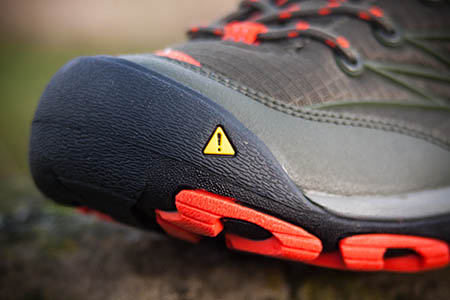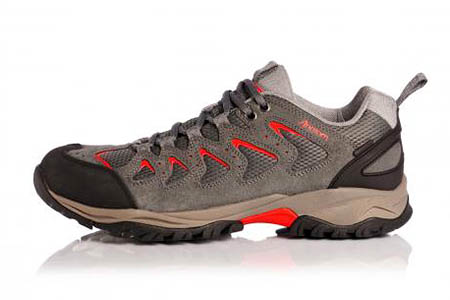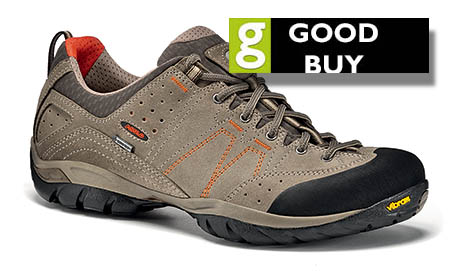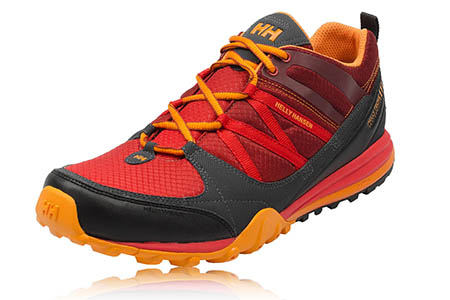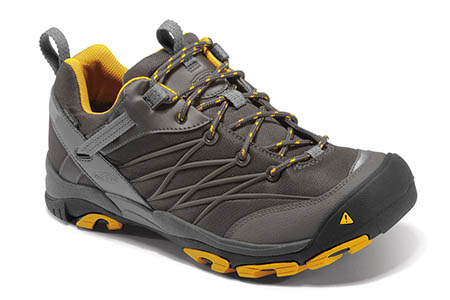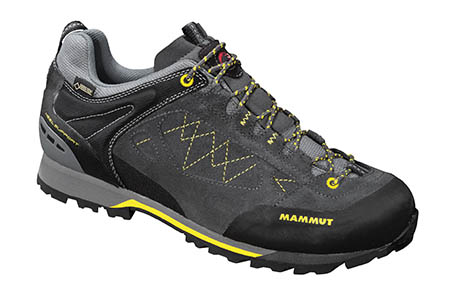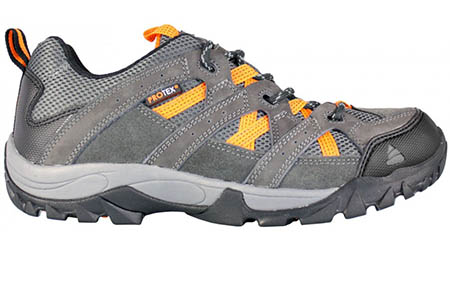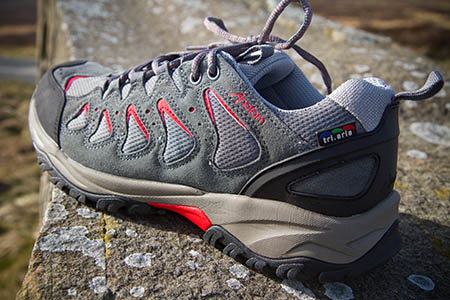Take a glance at the feet of most walkers and climbers when they’re not on the hills and you’re likely to see a pair of trail shoes.
Many outdoor types use what are variously described as approach or trail shoes as their standard ‘non-boot’ footwear. They’re comfortable, hard-wearing and, quite possibly, an outdoors fashion statement too.
But with the onset of, hopefully, some kinder weather, trail shoes can also be substituted for boots as the threat of more extreme conditions on the hill recedes.
We put eight different models, supplied by the brands, to the test, both on the streets and occasionally in the pub. They all performed well in that respect. But how did the shoes meet the challenge of a trip on to the hills?
Anatom V1 Trail
Price: £70
Country of manufacture: not stated
Weight: 992g
Colour: grey/red
Men’s sizes: 7 to 11½
Womens’ sizes: 3 to 8
The Anatom V1 is available either with a waterproof membrane or without. The uppers are quite soft, a combination of Nubuck, suede and polyester mesh and there is good padding round the ankle cuff.
A rubber toe cap provides added protection at the front of the V1 Trail. The heel is well held by the cradle support system.
We tested the version of the V1 Trail with Anatom’s own tri.aria waterproof membrane, which kept the water out but there was a noticeable build-up of perspiration on warmer days.
Traction from the Trail Grip 1 outsole on gravel, stone and grass was good and braking downhill was good.
The shoes are comfortable, with plenty of cushioning on hard surfaces, with the EVA midsole providing lots of absorption.
The forefoot is fairly wide, though the shape of the shoe does cut in a little in the big toe area.
The V1 Trail offers very good value for money for a trail shoe that’s a good all-round performer. Great for everyday use and on maintained trails, though for serious scrambly routes a little on the soft side in both the sole and upper.
Performance 27/35
Comfort 28/35
Quality 6/10
Value for money 17/20
Total score: 78/100
Asolo Agent GV
Price: £130
Country of manufacture: Romania
Weight: 880g
Colour: grey
Men’s sizes: 6 to 13½ (including half sizes)
Womens’ sizes: 3½ to 9½ (including half sizes)
The Agent, and its similar women’s version the Outlaw – how do they come up with these names? – are good looking shoes based on Asolo’s Natural Shape last.
Viewed directly from above, the shoe does mirror the shape of an average foot, if such a thing exists. Which sort of begs the question: why don’t all manufacturers shape their shoes and boots like a foot?
The toe section is longer where the big toe fits and then shortens progressively for the smaller toes.
The forefoot is quite wide and in use there is no sense that the front of the foot is pinched.
The heel cup also supports the back of the foot well and there was no suggestion of heel-lift on uphill sections.
The only slight discomfort was on the top of the instep if the shoes were tightened well. The side sections of the tongue would benefit from a little more padding.
The uppers are formed mainly from one-piece water-resistant 1.8mm suede, with an added tough runner toe box which protected well from stones and rocks on our test routes.
The low ankle cuff also has padding.
The outsole actually feels quite hard, and there’s a definite double ‘clomp’ as the heel then forefoot of the curved sole hit hard surfaces, but there’s enough shock absorption in the mono-density polyurethane midsole and there was no jarring and no discomfort on the soles of our feet after our walking tests.
The Gore-Tex Extended Comfort waterproof membrane kept the feet dry and was reasonably breathable.
The outsole, also part of the Natural Shape design, is an Asolo-Vibram design with what the company says are self-cleaning lugs, though any extra ability to deal with good old British mud was marginal.
On rock, grass and gravel trails, traction and braking were good.
A comfortable, well made shoe with a nice design. The women’s version, the Outlaw GV, is similar though not identical, with styling differences but the same Natural Shape design.
Performance 30/35
Comfort 30/35
Quality 8/10
Value for money 13/20
Total score: 81/100
Berghaus Prognosis II GTX
Price: £100
Country of manufacture: China
Weight: 852g
Colour: grey/black
Men’s sizes: 7 to 12 (including half sizes)
Womens’ sizes: 4 to 8 (including half sizes)
The Prognosis II GTX shoes are fairly conservative in styling compared to some of the more vivid colours sported by other brands on our test.
The shoes feel roomy, and this was borne out by a direct comparison of sole lengths with some of the other brands where the Berghaus looks about a half-size longer than many. You may want to bear that in mind when trying on.
The forefoot is wide and there was no feeling of constriction around the foot while walking.
Comfort was good, with ample cushioning underfoot. The laces needed careful tightening to avoid them coming unkotted while on the move.
Traction from the Vibram soles uphill on dry rock, gravel and grass was good, and downhill braking was good on these surfaces too.
In the wet, the Prognosis II GTX was impressive. Uphill traction on gravel, wet grass, firm mud, wet stone flags and rock was very good. The only slippage occurred on soft, gloopy mud which defeats virtually all our footwear for grip.
Downhill, braking on all surfaces was good too, and the shoes gave surefooted confidence.
Breathability of the Gore-Tex membrane was fine, and the shoes kept feet dry.
A very competent pair of shoes. Comfortable enough for everyday use, but technical enough to provide assured walking on the trail.
Performance 31/35
Comfort 29/35
Quality 7/10
Value for money 15/20
Total score: 82/100
Helly Hansen Kenosha HT
Price: £90
Country of manufacture: Vietnam
Weight: 668g
Colour: red/orange/grey
Men’s sizes: 7 to 12½ (including half sizes)
Womens’ sizes: 4½ to 8 (including half sizes)
Helly describe these as trailrunning shoes and the lugs on the soles are fairly shallow. In fact, the outsole is flatter than many in the test, with a less marked curve to it than those aimed more purely at walkers.
The running pedigree is evident too in the fact the Kenosha HT were the lightest in the test.
Comfort was good though, with good cushioning on hard ground, thanks to the EVA midsole. The shoes provide good stability and support and Helly Hansen’s own Helly Tech waterproof membrane kept the water out. Breathability was fine too.
Protection from stones on the trail was markedly good for such a lightweight shoe and the fit was good, with no heel lift on uphill sections.
The Kenosha HT worked very well on dry trails, gravel paths and dry rock, but its grip was less impressive in the wet. Mud and wet grass gave poor traction uphill and there was definite sliding when braking downhill in the wet on grass and rock.
The shoes came into their own when moving fast in good weather on the trail and are clearly the best bet for someone who want to combine trail running with walking. It’s just a shame their grip in the wet didn’t match that in the dry.
Performance 25/35
Comfort 30/35
Quality 8/10
Value for money 15/20
Total score: 78/100
Keen Marshall WP
Price: £100
Country of manufacture: China
Weight: 912g
Colour: grey/orange
Men’s sizes: 7 to 10 (including some half sizes)
Womens’ sizes: 3½ to 7½ (including some half sizes)
The Marshalls were instantly comfortable, with a good wide forefoot and quite soft uppers.
The fabric material is reinforced with criss-crossed plastic and there is a stiff rubber toe cap with additional plastic protection behind it. The heel box is also reinforced internally to add some protection.
Waterproofing is from Keen’s own KEEN.DRY membrane which kept the rain out. Breathability was good.
The outsole is also Keen’s own rubber design. The lugs are not as deep as some models. Cushioning is from polyurethane midsole and was less marked than some of the models in the test, though still adequate for most terrain.
Uphill traction was fairly good, both in the dry an in the wet, as was downhill braking, though the performance wasn’t quite as good as the best, with a very small amount of slippage on our test routes.
The Marshall WPs are great for everyday use and will cope with maintained trails, though wet rock performance was not as assured as some of the shoes.
Performance 28/35
Comfort 27/35
Quality 8/10
Value for money 15/20
Total score: 78/100
La Sportiva Xplorer
Price: £130
Country of manufacture: China
Weight: 836g
Colour: blue/black/yellow
Men’s and women’s sizes: 5 to 12½ (including half sizes)
The Xplorer was the only shoe in the test without a waterproof membrane of some sort, and it was a very different beast to the rest of the shoes.
There’s a definite hint of the rockshoe to the Xplorer, with its lacing going almost to the end of the toe. The uppers are a synthetic mesh fabric, with lining only in the rear section, making them by far the most breathable. But, if it rains, you’re going to have wet feet.
It’s possible to trudge through shallow puddles and muddy sections without getting wet feet, thanks to an extended rand and solid section. The La Sportiva shoes are genuine approach shoes, that you can probably keep on for some fairly serious scrambling or even easier crag routes.
The front of the outsole is designated a ‘climbing zone’ which came into its own on small scrambling footholds. The outer sections of the sole are hard which enables good edging.
In fact, the grip from the La Sportivas was remarkable, with exceptionally good traction on dry and wet rock, wet grass and gravel, with downhill braking just as assured. The only problem came with gloopy mud, where the fairly shallow lugs quickly clogged up.
Grip on quite steep gradients was sure, surpassing all others in the test.
The outsole is Vibram’s X-Traction, made from Idro Grip compound. It feels quite hard when it hits the ground and there was a worry that this would make for uncomfortable walking, but there is enough cushioning from the dual-density EVA midsole, particularly under the heel, to make the Xplorers comfortable enough on the trail too.
The blue uppers combined with bright yellow laces will ensure your approach is noticed!
The La Sportiva Xplorer is a more specialist shoe that performs brilliantly on rock while offering great breathability. We can imagine summer Alpine walkers getting good use from these shoes.
Performance 33/35
Comfort 27/35
Quality 7/10
Value for money 13/20
Total score: 80/100
Mammut Ridge Low GTX
Price: £135
Country of manufacture: China
Weight: 1,192g
Colour: grey
Men’s sizes: 6½ to 13 (including half sizes)
Womens’ sizes: 4½ to 8½ (including half sizes)
The Mammut shoes are the beasts of the test: heaviest and chunkiest, more like a pair of cut-down boots than trail shoes, and the weightiest of the bunch.
Mammut says these have been designed especially with vie ferrate in mind. They’re described as ‘robust’ and they certainly have that feel.
Despite that, they perform well as trail shoes too, with good protection from the large rubber toe cap.
The uppers are a combination of velours leather, synthetic leather and fabric. The Gore-Tex Performance Comfort membrane kept feet dry and there is good protection around the ankle with a memory foam cuff.
The IronGrip sole is not like any other in the test. Its pattern has been designed, Mammut said, from the concept of sonar waves spreading out. Quite how that translates into grip we’ll leave hanging in the air, but the Ridge Low shoes did demonstrate good uphill grip and downhill braking.
Mammut said its flexible ribs and special lugs give increased grip on the iron stemples of a via ferrata. We’ll have to take their word on that one as we didn’t have a via ferrata handy during testing.
The shoe is very sturdy, and the Raichle pedigree in Mammut footwear – they were rebranded five years ago – and comfortable, though its weight might be a disadvantage over some of the lighter shoes on long, multi-day walks.
Cushioning was moderate and there was a slight pinching in of the big toe due to the shape of the front of the shoe. The sole is one of the stiffest in the test too, which squares with its mountain purpose.
The foot is well protected, with a very hard toe box, and a stiff heel cup too.
Grip was good, with uphill traction and downhill braking good in both the dry and wet on all our terrain surfaces on the test routes.
Waterproofing is provided by a Gore-Tex Performance Comfort membrane, which also gave good breathability, though the tough uppers add a little to perspiration build-up.
The Ridge Low GTX offers great foot protection and assured performance on rocky terrain, though the pay-off is extra weight and only moderate cushioning from the stiff sole and fairly thin midsole.
Performance 32/35
Comfort 25/35
Quality 8/10
Value for money 14/20
Total score: 79/100
Vango Trail
Price: £60
Country of manufacture: China
Weight: 932g
Colour: grey/orange
Men’s sizes: 7 to 11 (whole sizes only)
Womens’ sizes: 4 to 8 (whole sizes only)
The Vango shoes only come in whole sizes so it’s important to try them on to get the correct pair for your particular fit.
Underfoot cushioning was very good, and traction uphill on dry stone flags, gravel paths and grass was good, as was braking downhill on similar terrain.
Performance in the wet was also good from the Trails which were the cheapest model in our test.
The section around the big toe felt a little cramped and lacing had to be completed carefully to stop them loosening. The lacing doesn’t come very high up the shoe, which meant the tops of the Trails felt quite loose. The laces also had a tendency to come unknotted, no matter how we tried to tighten them.
The Vango ProTex waterproof membrane made for quite warm walking and there was a fair amount of perspiration at the end of a walk.
The uppers are a combination of suede and synthetic mesh, with a fairly soft toe box and heel cup adding a little protection, though the whole uppers are quite soft and protection on rocky routes was therefore not among the best.
The tongue and ankle cuff are, however, well padded and there was lots of underfoot cushioning, making the Vango shoes a comfortable general-purpose option at a very reasonable price. We wouldn’t recommend their use on tough rocky terrain as the uppers are soft and don’t afford a great amount of protection from sharp rocks or knocks on craggy routes.
Performance 26/35
Comfort 28/35
Quality 5/10
Value for money 17/20
Total score: 76 /100
Best in test: Berghaus Prognosis II GTX
Recommended: Asolo Agent GV
Recommended: La Sportiva Xplorer
Best performing all-round shoes were the Berghaus Prognosis II GTX. These combined comfort with good grip.
Just pipped for the top position were the Asolo Agent GVs. These had a similar performance and comfort but were pricier.
The La Sportiva Xplorer outclassed all others for grip on rock and other surfaces. If waterproofing isn’t important and your trips gravitate to scrambling and climbing, they are hard to beat.
Great value were the Anatom V1 Trail tri-aria shoes, which held their own against some more expensive models.
